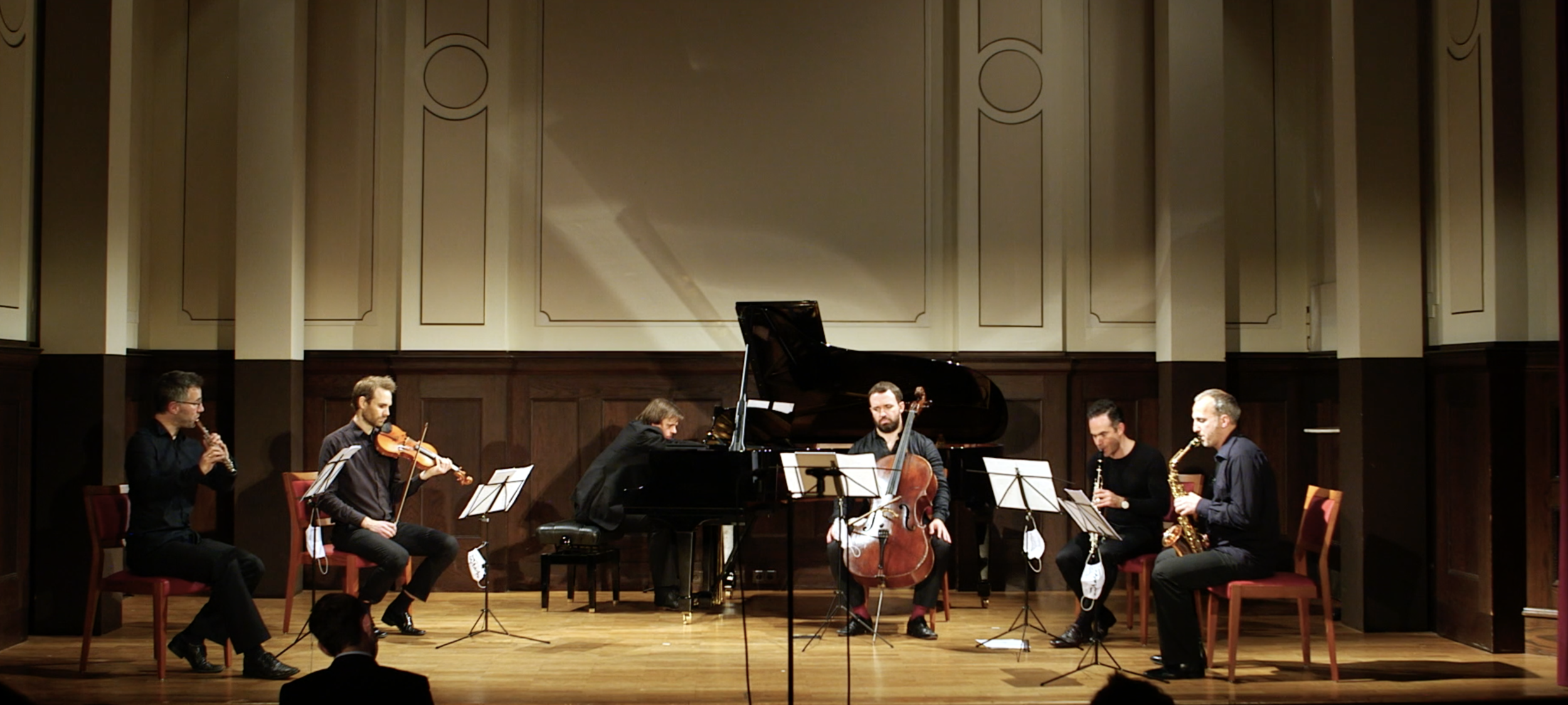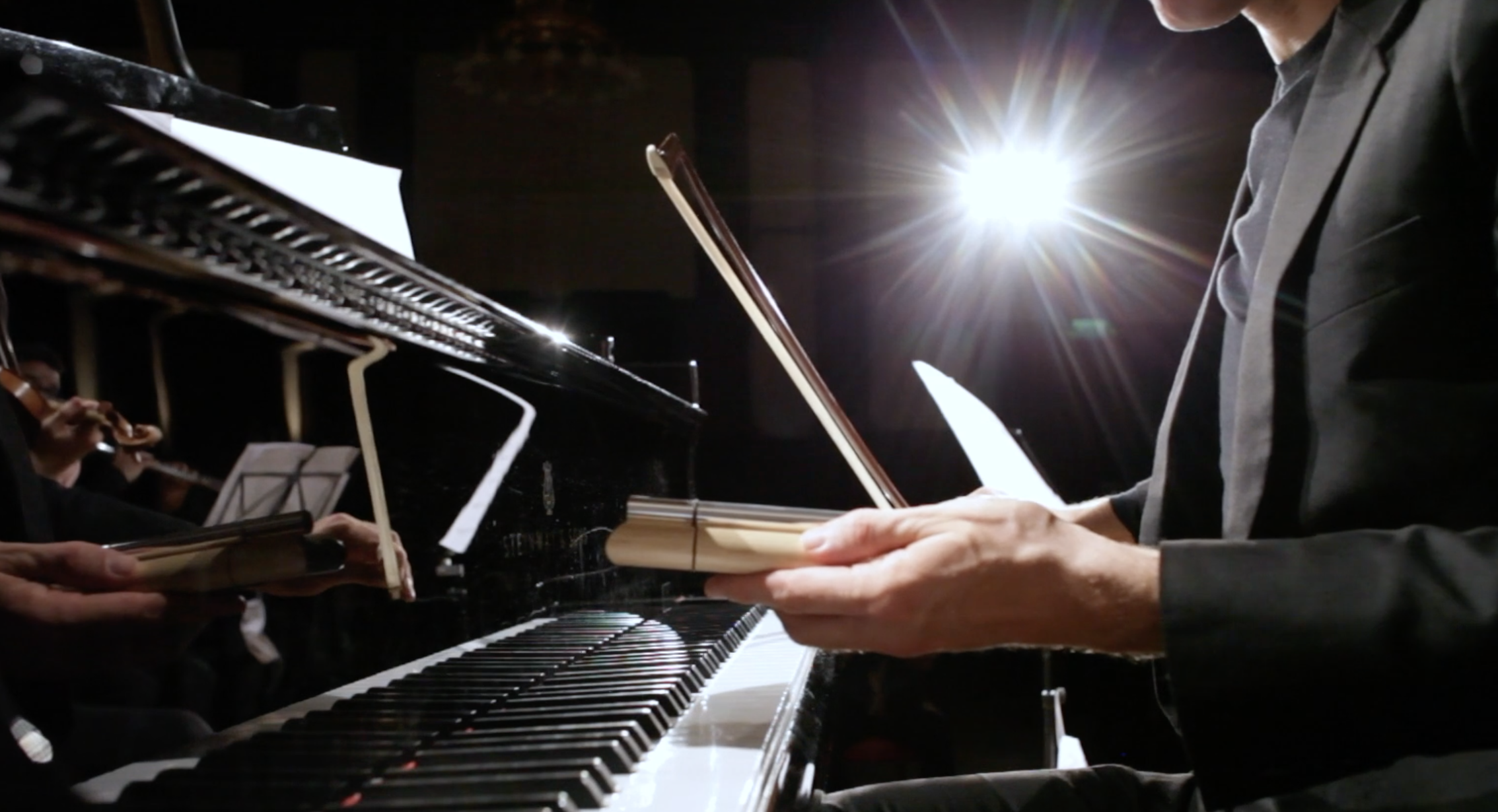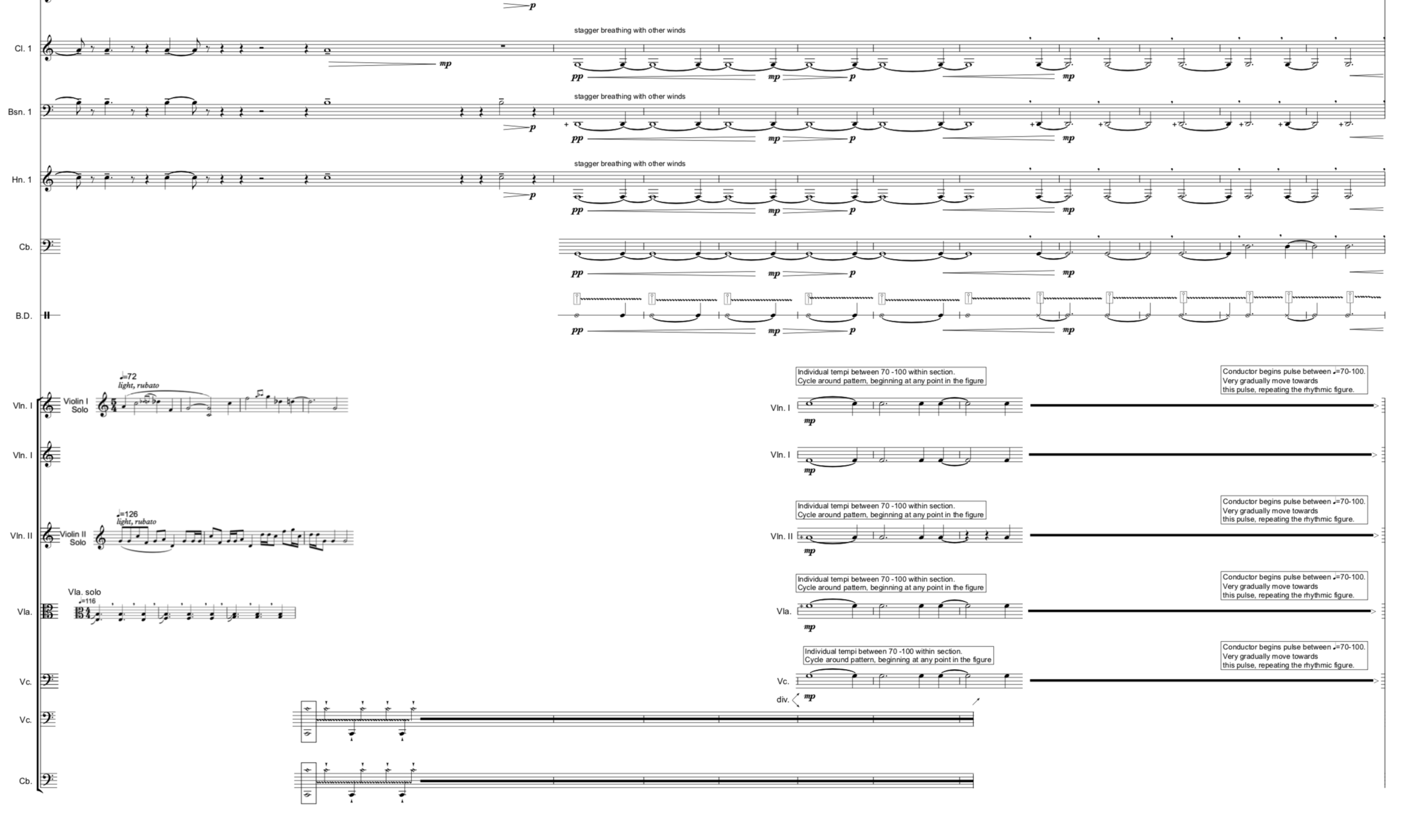t h r e a d
In my new interactive composition, Thread, I explore the perception of time and adaptation. Thread is a collaborative work for solo double bass and immersive projection, composed in collaboration with Tatsuru Arai (programming and projections) and Matthew McDonald (double bass, principal double bass for the Berlin Philharmonic and former principal for Ensemble Modern). The duration of performances ranges between 40 and 60 minutes.
With this work, I aim to create a kind of interplay between subjective and objective observation. I separate my material into two realms: the more natural, non-human, and atmospheric sound/noise world, and the musical, harmonic, and familiar material associated with human music-making. The work is modular, allowing flexibility in the order and duration of the individual pieces, so that the musician’s creative sensibilities can be explored during performance. I notate the piece to balance clarity of intention with sufficient flexibility for the performer.
The role of the visual projected material is to create an additional layer not only of time but also of the perception of the performance space. Projected over the performer are hand-drawn images of mine that will be altered through Arai’s algorithmic design. The fluid structures of the projections influence the perceptual structure of the performance space, causing the soloist to adapt musically in response.
Thread premiered at the Tongyeong International Music Festival 2024 in South Korea, who commissioned the project with the Ernst von Siemens Music Foundation.
p e n t - ( 5 g l e a n s )
PENT is a modular work created for Ensemble Zafraan as part of a concert program on October 30, 2020. In addressing the broader context of the other pieces in the program, I aimed to create a piece that incorporated contextual elements inclusive of the entire lineup. I decided to glean all compositional, musical, and sound material from the other pieces, connecting to the heritage these works have left us.
To forge connections with the other compositions, each module, or GLEAN, consists of material or concepts drawn from works by Wolpe, Webern, Feldman, and Mamlok—all commissioned in Berlin. These other works serve as a starting point, allowing musicians to gain insights into the entire program and offering them a fresh perspective on how to understand and perform these pieces. The five interchangeable movements, GLEANS, require new arrangements and interpretations for each performance. Any number of GLEANS can be utilized in each rendering of the piece. Each GLEAN functions as a complete work on its own or can be combined with other GLEANS. They can be arranged alongside and layered on top of one another in any order the musicians deem fit. The duration, order, layering, and instrumentation become the creative responsibility of those performing the piece.
The work engages with a specific musical heritage rooted in Berlin by conserving artistic and musical ideas from earlier compositions. Built into the score of PENT is the necessity for musicians to assume greater creative agency, contributing their own ideas, tastes, and interests to the work—invigorating their role in the present. The intention is to create active, evolving temporal links (past, present, and future) while being specific to place. The work connects temporally to the specific program and context of its premiere on October 30, 2020. Ultimately, PENT aims to make room for the future by creating a flexible modular work that requires musicians to make significant creative decisions for each new performance.
The work seeks to dissolve the traditional composer-performer relationship, shifting the composer’s role from sole creative authority to that of an initiator of a creative process, and transforming the performer from interpreter to creative participant.
PENT, along with the program it was part of, was performed twice on October 30, 2020. Below are the two different renderings/versions of PENT.
Simon James Phillips PENT - Zafraan Ensemble 30.10.2020 (version 1)
Simon James Phillips PENT - Zafraan Ensemble 30.10.2020 (Version 2)
s k e i n
SKIEN is an orchestral composition that utilizes just intonation, spatialization, and duration to explore the concept of time from various perspectives. The piece primarily consists of long notes played using a scale derived from simple seven-limit just intonation pitches, creating a rich expanse of harmony and timbre. The work maintains a soft dynamic, with a maximum volume of mezzopiano. Some musicians in the orchestra are positioned to the sides and behind the audience, adding subtle colors that enhance the sense of spatialization of the sound emanating from the main ensemble on stage. While the work is monumental in certain aspects, it evokes the image of an enormous cloud hovering above the earth, recognized as monumental yet composed of ephemeral air and mist.
SKIEN was entered in the Rychenberg Competition and was shortlisted as one of ten nominated works (from 191 registered composers) to be recorded and filmed by Musikkollegium Winterthur in Switzerland. It was also selected as a finalist for Kaleidoscope Chamber Orchestra's 2020 call for scores, chosen from over 8,000 compositions.
(SKEIN (definition) - 1 A length of thread or yarn, loosely coiled and knotted.
1.1 An element that forms part of a complex or complicated whole. ‘he weaves together the skeins of philosophy, ecology, folklore, and history’ 2 A flock of wildfowl in flight, typically in a V-shaped formation.)
o u t e r n a t i o n a l
I was invited by dramaturg Eliza Erkelenz and Persian musician Elshan Ghasimi to create a collaborative composition for the Outnational project at the PODIUM Festival in Esslingen. For this work, I collaborated with four Persian musicians: Elshan Ghasimi (tar and voice), Mona Matbau Riahi (clarinet and voice), Golnar Shahyar (voice), and Jawad Salkhordeh (tonbak, percussion, and voice). My role as composer shifted to become that of a witness and facilitator. I diffused sound recordings through a four-channel system. Each musician was positioned in a corner of an intimate performance space, with the audience seated on stools between them. The piece is a collage of traditional Persian songs, instrumental improvisation, recited text, birdcalls, and field recordings.
p u b l i c p e o p l e
I collaborated on a collective composition with Alwynne Pritchard, Julia Reidy, and Chris Heenan for the Splitter Orchester and Ensemble Mosaik, conducted by Ilan Volkov. Our piece, Public People, is not only a work for two ensembles but also an exploration of group structures and the methods we've developed to handle musical material. While the Splitter Orchester is deeply rooted in free improvisation and collective working, Ensemble Mosaik often engages in dialogical processes with composers to create new works. These differing approaches lead to unique aesthetics, working methods, and conclusions.
Public People questions both ensembles as institutions and plays with the dialectical relationships of their distinct structures, addressing themes of approximation and differentiation within a broader social context.
f l a w
Commissioned by Ensemble Offspring and the Australian Art Orchestra, FLAW at the Sydney Festival in January 2016. This 35-minute composition for organ, large ensemble, and multi-channel surround sound features a unique ensemble of strings, trumpet, percussion, reel-to-reel tape machine, turntable, electronics, soprano, and pipe organ. The work, presented alongside two other new commissions from Austin Buckett and Alvin Lucier, creates an immersive sound world that utilizes development and spatialization to explore the perception of time.
"This is sensuous, immersive ambient music and a stunning example of how a good composer can distil the bombast and drama of the pipe organ into a thing of simple grace and beauty."
The Guardian
"Uncompromising assertiveness"
The Sydney Morning Herald
"The Phillips, FLAW, was my favourite of the night"
SYN
pe r t o d o a r
Perto do Ar (Close to Air) is a 50-minute immersive composition for brass sextet that uses spatialization and an extremely resonant acoustic to draw out complex overtones and sound colors. At particular points during the performance, members of the ensemble move around the audience, making full use of the directional possibilities of the work.
Perto do Ar premiered on November 1, 2014, in Lisbon, Portugal. This significant date marks the anniversary of the Great Lisbon earthquake of 1755 and is also All Saints Day. The premiere took place in the magnificent Panteão Nacional, where many of Portugal's most important figures are buried. This work was produced by Teatro Maria Matos, Lisbon, with the generous assistance of the Australia Council for the Arts and was first performed by members of the Portuguese Chamber Orchestra alongside German trumpeter Nils Ostendorf.
b l a g e
BLAGE 3 was an extended installation and performance piece that I curated for the opening of the Tanz im August Festival in Berlin. It was a one-off, five-hour uninterrupted improvisation with an ensemble of six Berlin experimental artists: Tony Buck (drums and percussion), Werner Dafeldecker (double bass), BJ Nilsen (electronics), Liz Allbee (trumpet), Arthur Rother (guitar), and me, Simon James Phillips (piano).
The ensemble was placed in the center of a large dance studio, and the audience, free to come and go, was admitted only once the work had begun—unaware of the five-hour duration. We created expansive sonic atmospheres that incorporated outside concrete noise (via shotgun mics), extended techniques, and a sense of gradual overlapping thematic development. The performance was communicative and responsive, yet there was a continual sense of consensual disconnection among the artists. A reduced version of BLAGE 3 was released as a double CD set on Mikroton Recordings.






































